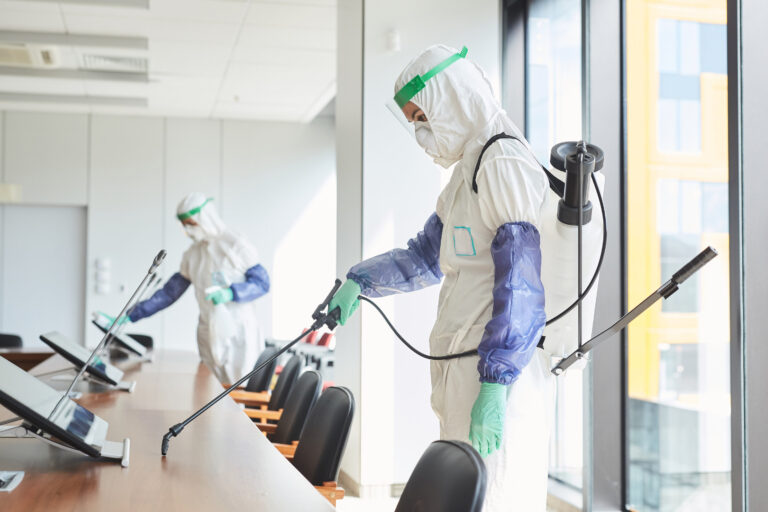Biohazards are biological substances that can pose substantial health and safety risks to humans, animals, and the environment. Encountering a situation involving hazardous materials can be incredibly overwhelming and distressing, making it crucial to take the appropriate measures to handle and dispose of these contaminants safely.
Typically, professional biohazard cleanup and remediation services like those offered by Sentry Restoration are the most effective and secure means to manage biohazardous threats, as they possess the necessary knowledge, experience, equipment, and resources to effectively tackle the situation. This article will explore the different types of biohazards, the dangers they pose, and the essential role of professional cleanup teams in mitigating these risks.
There are four main categories of biohazards, each with distinct sources, characteristics, and associated dangers. These classifications include: (1) viruses and bacteria, (2) human blood and blood products, (3) animal waste and carcasses, and (4) medical and laboratory waste. Some common scenarios that may involve biohazards include crime scenes, unattended deaths, hoarding situations, and accidents involving hazardous materials. In each of these situations, potentially harmful substances necessitate the involvement of trained professionals to ensure the area’s effective and safe remediation.
The dangers associated with biohazards vary according to the nature of the hazardous material involved but can range from mild skin irritation to severe infections and diseases. Some examples of biohazard infections and illnesses include Hepatitis B and C, HIV, E. Coli, and Salmonella. These pathogens can be easily transmitted through direct contact, ingestion, or inhalation, making it critical that anyone who encounters a hazardous situation maintains a safe distance and avoids any contact with the contaminated area.
Attempting to handle biohazardous materials without the proper training, knowledge, and equipment can put you at substantial risk of exposure to hazards and complications. Professional biohazard cleanup and remediation teams like Sentry Restoration’s skilled personnel are trained to address these dangerous situations while adhering to strict safety standards and regulations. With an in-depth understanding of biohazards and their associated risks, these experts work meticulously to remediate and restore affected areas, ensuring a secure and healthy environment.
Throughout this article, we will discuss the step-by-step process involved in professional biohazard cleanup and remediation, detailing the specific techniques and precautions experts employ to eliminate biohazards safely and efficiently. Additionally, we will provide valuable information to help you determine when professional biohazard cleanup services are necessary and how to select a reliable and reputed company to handle your biohazard situation.
A Comprehensive Guide to Biohazard Cleanup and Remediation Services
Biohazardous materials can be found in various situations and pose significant health risks if improperly handled and disposed of. In this blog, we will delve deeper into biohazards, emphasizing the crucial role of professional biohazard cleanup and remediation services in managing these hazardous materials. So, without further ado, let’s dive into the essential aspects of biohazard cleanup.
1. The Step-by-Step Process of Professional Biohazard Cleanup
Professional biohazard cleanup is a systematic process that covers all the bases, ensuring a thorough and secure remediation of the affected areas. The step-by-step process typically includes:
a. Evaluation and Planning: Professionals begin with an in-depth assessment of the biohazardous site. This evaluation helps them determine the type and extent of contamination, allowing them to create a tailored cleanup plan.
b. Safety Preparation: The cleanup team follows strict safety protocols to minimize their biohazard exposure. This preparation includes wearing personal protective equipment (PPE), such as gloves, masks, and coveralls, and setting up containment barriers to prevent cross-contamination.
c. Contaminant Removal: The team employs specialized techniques and equipment to remove biohazardous materials, such as bodily fluids, tissues, and contaminated objects, from the affected areas.
d. Cleaning and Disinfecting: After removing the contaminants, the team thoroughly cleans and disinfects the area using EPA-approved disinfectants, ensuring all traces of biohazards and potential pathogens are eliminated.
e. Deodorizing and Decontaminating: The cleanup team takes special care to tackle lingering odors and remove any remaining contaminants from surfaces, materials, and the air.
f. Restoration: If warranted, the team will repair or replace damaged structures and materials, bringing the area back to its pre-contaminated condition.
2. When to Seek Professional Biohazard Cleanup Services
Understanding when to seek professional biohazard cleanup services is vital to ensure the safety and well-being of everyone involved. Some common situations that demand the expertise of a professional cleanup team include:
a. Crime Scenes: These areas often contain blood, bodily fluids, and other hazardous materials. Law enforcement may require the site to be cleaned and remediated to avoid tampering with evidence.
b. Unattended Deaths: In cases of undiscovered fatalities, rapid decomposition can lead to the presence of hazardous biological materials, which should only be handled by trained professionals.
c. Infectious Disease Disinfection: Areas exposed to contagious pathogens, such as COVID-19, require sensitive and expert disinfection to minimize the risk of transmission.
d. Hoarding and Filth: Hoarding situations can involve various biohazards, including human waste, animal carcasses, and contaminated items, which can only be handled safely by a professional team.
e. Sewage and Water Damage: Exposure to sewage or water damage can cause bacteria, viruses, and mold growth, necessitating the need for professional biohazard cleanup and remediation services.
3. Choosing the Right Biohazard Cleanup Company
Selecting the right biohazard cleanup company is vital for successfully and safely restoring the affected areas. Here are some factors to consider when evaluating potential service providers:
a. Experience: The company should have a proven track record in managing a wide range of biohazard situations, illustrating its expertise and successful history.
b. Licensing and Insurance: Ensure that the company is properly licensed to perform biohazard cleanup services and carries adequate insurance coverage to protect you and your property.
c. 24/7 Availability: The company should offer around-the-clock availability, as emergencies can happen at any time.
d. Compliance with Regulations: The service provider must adhere to strict local, state, and federal guidelines, regulations, and protocols, such as OSHA standards, EPA guidelines, and state/environmental disposal regulations.
e. Customer Testimonials: Look for positive customer testimonials and reviews, showcasing the company’s commitment to exceptional service and client satisfaction.
4. The Benefits of Hiring a Professional Biohazard Cleanup Team
There are several advantages to entrusting the responsibility of biohazard cleanup to a team of professional experts, including:
a. Safety and Protection: Professionals follow strict safety protocols and wear the appropriate protective gear to minimize the risks associated with handling biohazards.
b. Expert Knowledge: Professional teams leverage their knowledge, experience, and understanding of biohazards to ensure proper remediation and disposal.
c. Advanced Equipment: Professionals use specialized equipment and EPA-approved disinfectants to guarantee effective and thorough cleanup.
d. Compliance with Regulations: Professional biohazard cleanup teams adhere to local, state, and federal guidelines and regulations, ensuring a legally compliant and reliable service.
e. Stress Reduction: Involving an expert team of professionals relieves the burden of handling biohazardous materials independently, mitigating the emotional and mental stress associated with these situations.
Conclusion
Biohazard cleanup and remediation is an essential service that should only be performed by trained professionals with extensive experience handling hazardous materials. By engaging a reputable company like Sentry Restoration, you can guarantee a safe, effective, and reliable cleanup process, ensuring the utmost safety and well-being of all those involved.
Remember, knowledge is power—equipping yourself with the right information and knowing when to seek professional help can make all the difference in mitigating biohazard-related risks for you and your loved ones.



